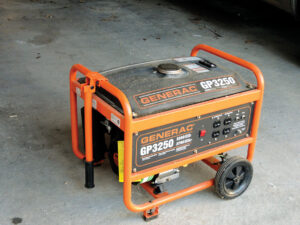
Winter storms can bring chilling winds, ice and snow – and cause power outages. Already this winter an ice storm hammered Oklahoma electric cooperative members leaving many in the dark for days.
Generators can help keep the electricity on until power can be restored. However, those who use generators must be mindful of risks such as electric shock and toxic exhaust. According to the U.S. Consumer Product Safety Commission (CPSC), more than half of the annual accidents with generators occur between November and February, the coldest months of the year.
Improper use of a standby or portable generator can lead to injury or even death. Help keep yourself and others safe by learning about important safety measures.
Since generators come in a variety of sizes, capacities and power sources, begin by reading and following all manufacturer instructions. Before you use a generator, inspect it for damage. If no damage is found, prepare it for use in an area outside of the home and away from dangerous or wet conditions.
During cold weather conditions the thought of setting up the generator away from the warmth of one’s home can seem unpleasant. Yet, it is a necessary safety step. According to CPSC, the most dangerous generator hazard during the winter months is carbon monoxide emissions, which contribute to 85 percent of annual toxic gas accidents, aside from house fires.
Because carbon monoxide is invisible and odorless, you should always run the generator outdoors, as carbon monoxide levels may be fatal within minutes in enclosed areas. Avoid using generators inside a house, shed, crawlspace, basement or garage. Even with a fan or ventilation, carbon monoxide can build up inside and be toxic for hours afterward.
Be aware of the symptoms of carbon monoxide poisoning, which include headaches, dizziness, confusion, fatigue and nausea. If you suspect that someone has been exposed to carbon monoxide, move them into fresh air immediately. It is also a good idea to install carbon monoxide detectors in your home. Follow the instructions in the manufacturer’s guide for proper placement, and test the batteries regularly.
In 2015, USA Today reported that four young people and their dog had been found dead as a result of carbon monoxide. A generator had been running in the basement of their Maine cabin, and before it ran out of gas, the odorless, colorless gas tragically poisoned and killed those inside the house. According to the Centers for Disease Control and Prevention, on average there are 430 deaths from carbon monoxide each year.
Carbon monoxide produced by generators is not the only hazard from generator use. Backfeed is a situation where a generator is feeding electricity back through the electrical system and meter into the power lines. This jeopardizes the safety of linemen attempting to restore power, as well as anyone who may be near downed or sagging lines that become energized.
To prevent backfeed, standby generators should have a transfer safety switch installed by a professional. This

device automatically separates your home system from the utility system. Portable generators should never be plugged directly into a home outlet or electrical system; use a heavy-duty, outdoor-rated extension cord to plug appliances into an outlet on the generator for power. Your generator should have more output than the wattage of the electronics you will plug into it.
Be sure to keep pets and children a safe distance away. When the generator needs a refill on gasoline, first reduce flammability by turning off the machine for at least 10 minutes.
For more information on winter safety, visit SafeElectricity.org or your local electric cooperative.








